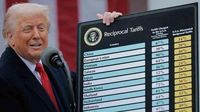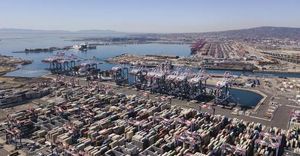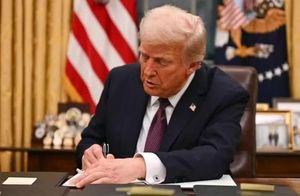On Wednesday, April 2, 2025, U.S. President Donald Trump announced a new reciprocal tariff policy for all imports to the United States, setting the stage for significant economic shifts. The reciprocal tariff, which is set at a staggering 32%, is designed to match the tariffs imposed by other countries on American goods, effectively raising the stakes in international trade.
The implications of this policy are particularly pronounced for Indonesia, a nation whose economy heavily relies on exports. The announcement has raised alarms among experts and local businesses, as the tariff threatens to disrupt the economic stability of regions that depend on exporting commodities.
North Sumatra, a major producer of palm oil, exemplifies the potential fallout of this new tariff regime. According to data from the Central Statistics Agency (BPS, 2023), the palm oil sector contributes over 30% to the province's Gross Regional Domestic Product (GRDP). However, the Ministry of Agriculture (2024) predicts that the new tariffs could lead to a 20% decrease in palm oil export volumes in the first year alone.
This decline poses a severe threat not only to farmers but also to the broader community. As palm oil exports diminish, the income of local farmers will plummet, directly impacting their livelihoods. The ripple effects could extend to public services, including education and healthcare, as regional governments face budget shortfalls.
Similarly, West Java, known for its textile industry, is bracing for a downturn. The region has historically exported a significant amount of garments to the United States, but the new tariff policy is expected to result in decreased orders. The Ministry of Industry (2023) has warned that this could lead to increased unemployment, particularly among women who dominate the textile workforce.
With one-third of North Sumatra's workforce dependent on agriculture and plantations, the potential job losses are alarming. The Ministry of Manpower (2024) has indicated that if the export sector contracts, many workers could face layoffs as companies react to reduced demand.
In addition to the economic concerns, rising unemployment could exacerbate social tensions. Data from the Center for Community and Cultural Research shows that the economic difficulties faced in 2022-2023 have already led to social unrest in various regions. The fear is that the new tariffs will only intensify these issues, leading to more protests and instability.
In light of these challenges, experts urge the Indonesian government to adopt a multi-faceted approach to mitigate the impact of the tariffs. One critical strategy is the diversification of export markets. By seeking out new trading partners in Europe and Asia, Indonesia can reduce its dependence on the U.S. market, thereby lessening the risks associated with tariff fluctuations.
Improving product quality and competitiveness is another essential step. The government can facilitate access to technology and training for farmers and manufacturers, ensuring that their products meet international standards despite market pressures. Strengthening support programs for small and medium-sized enterprises (SMEs) is also vital to enhance their competitive edge.
Moreover, active trade diplomacy with the United States is crucial. Engaging in constructive dialogue to negotiate tariff reductions on Indonesian products can help alleviate some of the burdens imposed by the new policy. Experts believe that a proactive approach could yield positive results for Indonesia's export sectors.
As the situation evolves, the Indonesian government faces a pressing need to respond effectively to the reciprocal tariff policy. The stakes are high, as the livelihoods of millions depend on the success of these initiatives.
Meanwhile, the tech industry in the United States is also feeling the heat from the new tariffs. Apple, for instance, relies heavily on its supply chains in countries like China, India, Malaysia, and Vietnam. The new basic 10% tariff on all imports, effective April 5, 2025, and additional reciprocal tariffs set to take effect on April 9, 2025, could significantly impact production costs for the tech giant.
China, where most iPhones are manufactured, will face a total tariff of up to 54%, combining the 34% reciprocal tariff with an existing 20% tariff. Similarly, Vietnam, a key production hub for Apple's AirPods, Apple Watches, and MacBooks, will encounter a 46% tariff. India and Malaysia will also see substantial increases in tariffs, with rates of 26% and 24%, respectively.
These rising costs could lead to two significant outcomes for Apple: the company may choose to absorb the losses by reducing its profit margins, or it may pass the costs onto consumers by raising prices. Such a move could deter customers and decrease demand, creating a ripple effect across the tech industry.
The immediate market reaction was telling, with Apple shares dropping more than 7% in post-trading following the announcement. The stock closed at $223 on the day of the announcement but fell to around $207 in subsequent trading. This decline reflects broader concerns about the implications of the tariffs on profitability and market stability.
Historically, during the 2018 U.S.-China trade war, Apple successfully negotiated exemptions for some products, notably the iPhone. However, analysts suggest that the current landscape may not be as favorable, with expectations that the tariffs will remain in effect.
As both Indonesia and the United States grapple with the ramifications of these new tariffs, the potential for economic disruption looms large. The need for strategic action has never been more critical, with the livelihoods of many at stake. The coming months will be pivotal in determining how effectively these nations can adapt to the shifting trade landscape.






